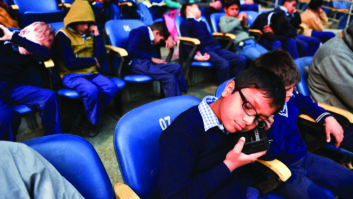GENEVA — In 2015, radio reached more than 454 million listeners every week throughout 33 European markets. That’s equal to 85.2 percent of the population in those countries, confirming radio’s popularity.

David Fernández Quijada says there are three main challenges facing radio in the current climate: a need to engage with younger audiences, changes in the devices used and the role of car radios.
But competition for listeners is constantly increasing with the addition of new audio services along with other news and entertainment outlets. This is reflected in the time spent listening to radio, which has dropped 8 percent in five years; it stood at 2 hours and 29 minutes per day across Europe in 2015.
LINEAR CONSUMPTION’S STRENGTH
Although it is possible to listen to radio on-demand, both catch-up radio and podcasts are a tiny fraction of total radio consumption. For example in the United States, consumption of linear radio is 33 times higher than podcasts (Q3 2016, Edison Research). In the United Kingdom, the proportion is 38:1, the same as for catch-up radio (autumn 2016, RAJAR).
Audiences therefore mainly listen to linear radio. Most of that listening is on traditional broadcast networks, where the number of available stations is limited by the capacity of the spectrum, rather than via internet, which gives access to thousands of stations all over the world. In the U.K., for instance, internet radio is only 8 percent of total consumption (autumn 2016, RAJAR). For France, Germany, Italy and Spain, where there are no official internet radio figures, the EBU estimates that 6–10 percent of total radio consumption is over the internet.
Similarly, linear consumption is preferred over on-demand, including podcasts. Most podcast users are actually heavy audio consumers, including of radio. Interestingly, they have a slightly different profile from radio listeners; they are younger and better educated and, for the time being, mostly male. More than a threat, podcasts are becoming an important supplement to broadcast radio, enhancing the listener’s experience. Podcasters seem to be able to identify topics and target groups relatively underrepresented on linear radio.
CHALLENGES

Radio weekly reach across Europe (2010–2015)
Note: Average based on 21 markets, 20 for youth. Definitions may vary by market. Source: EBU, based on members’ data
As can be seen from the figures above, radio consumption is changing, yet the pace of this change seems to be slower than often predicted. However, this should not mean business as usual for broadcasters; they really need to identify the most important battles to fight.
From my perspective, there are three main challenges facing radio in the current climate: a need to engage with younger audiences; changes in the devices used; and the role of car radios.
Younger Audiences
Traditionally young people have listened less to radio due to generational factors, namely the vast range of activities young people have available to them. Although 82 percent of young people listened to radio weekly in 2015, almost the same as in the population as a whole, they tended to spend less time doing so: just 90 minutes a day. However, in this case the drop is faster than that in the overall population, as total listening time among younger audiences has dropped 13 percent in five years.
Nowadays younger listeners are driving new consumption patterns, with listenership percentages for new devices much higher than in the rest of the population, even two or three times as many in countries such as France and Italy. Similar proportions are found when podcast consumption is measured. So, broadcasters need to be there in a prominent position, which requires an attractive, enhanced offer.
Devices

Time spent listening to radio across Europe (2010–2015)
Note: Average based on 20 markets, 18 for youth. Definitions may vary by market. Source: EBU, based on members’ data
Western European countries have seen a decline in sales of traditional radios. This is not just a trend but also a permanent change due to new multipurpose devices, on which radio is just one of many different functions. Not only phones, tablets and computers, but even TV sets now also feature radio. In most western European countries these devices represent around 10 percent of the total time spent listening to radio, a figure that is slowly growing and is expected to continue doing so.
We also know that when these devices have both broadcast and internet connectivity, people tend to use broadcast tuners. This is why campaigns to include or activate broadcast chips in smartphones are so important.
Car Radio
The increasing market penetration of connected cars along with the prospective development of autonomous cars have challenged the comfortable position radio has enjoyed on the dashboard for the last few decades. How will behaviors change? We can see that music streaming services have grown mainly at the expense of physical music formats though not of radio. If the same pattern applies to cars, radio may retain its dominant position but this is more likely if radio is able to offer a richer experience, for example by adding the sophistication of internet in the form of hybrid radio services.
Radio is likely to change as much as it has over its first century, but much more quickly. As an expression of social and cultural identity its future is not in jeopardy; however, the way it is consumed is likely to be shaped not just by current broadcasters and stakeholders but also by new players. Exciting times!
The author is senior media analyst for the Media Intelligence Service of the European Broadcasting Union.
Radio World welcomes other points of view. Please send comments to [email protected].











